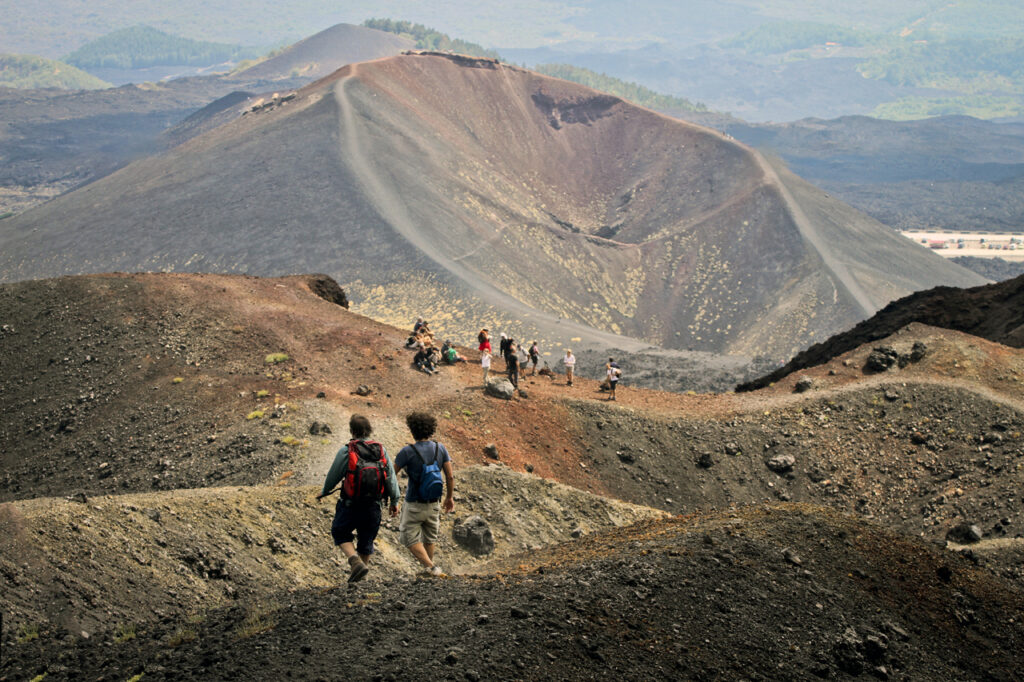Facing Etna is not like a simple walk in the countryside. Whether it’s a 2.000 m trek or a hike through the Summit Craters, the right equipment makes the difference between an extraordinary experience and a day ruined by cold, wind or unsuitable shoes. Dressing properly for a hike on Mount Etna means respecting the volcano and your own body, in every season.
Spring on Mount Etna: Mild but unpredictable climate
During the months of April and May, Etna shows itself in all its splendor. The snow melts and nature awakens, the slopes turn green, the air is sparkling.
But beware: even if you go down to the valley in t-shirts, in altitude the temperature can drop sharply.
To face the Etna spring well, it is advisable to dress “onion” at least 3 or 4 layers: a breathable microclimate base layer, a fleece and a jacket windproof or waterproof shell are the ideal combination.
The long trousers, preferably in technical material, will protect you from wind, cold and direct contact with the vegetation and the scoriaceous surface of the lava.
The shoes must be sturdy, preferably trekking, with a well-sculpted sole, for example in Vibram, that guarantees grip on wet and sandy soils.
Do not forget sunglasses, hat and sunscreen: the sun, although not burning, reflects strongly on the snow and dark rocks.
If you plan to stay more than a couple of hours bring with you at least one liter of water, if more than five hours at least one and a half liters of water.
Summer: warm in the valley, cool at the Summit
In summer many people underestimate the excursion to Mount Etna, thinking that a T-shirt and sneakers are enough. But above 2.000 meters, even in July and August, the wind can be biting and the temperature can drop below 15°C.
Even in summer, therefore, the layer clothing wins. Bring with you a breathable t-shirt, lightweight fleece or windproof jacket, to wear especially during stops or when climbing over the most exposed craters
Avoid shorts: better light long pants, which protect you from the sun and volcanic sand that can be abrasive.
Trekking shoes are essential, especially if you plan to walk on lava sand trails or unstable rocks. Bring with you in your backpack a cap for the sun and an abundant supply of water, at least one and a half liters per person: the air at altitude is dry and it is easy to dehydrate.
Not to be underestimated, even in summer it is important to use trekking boots over the ankle.
Autumn: warm colours and first snowfall
October and November are fascinating months on Mount Etna: the volcano is golden and red, and the days are still long. But don’t be fooled by the beauty of the landscape: the weather can change suddenly, with rain, storms and sudden temperature drops.
In autumn it is important to choose more thermal clothing. Wear technical underwear, a thick fleece and a waterproof windbreaker. The trekking trousers can be reinforced or slightly padded. Light gloves and a cap are recommended, as well as a tubular scarf or neck warmer, also comfortable to protect yourself from wind-lifted ash.
Shoes must be waterproof and well closed: in some areas you may find ice, especially early in the morning
Winter on Mount Etna: the wildest aspect
Visiting Etna in winter is a powerful and suggestive experience. The snowy landscapes, the black of the lava flows that gradually give way to white, the absolute silence: everything contributes to create an almost lunar atmosphere. But it is also the season that requires the greatest preparation.
The clothing must be high mountain. Heavy windbreaker, thermal fleece, warm technical underwear and winter trekking or ski pants are essential. Gloves, hat and technical socks are also not optional: they protect from cold, wind and moisture.
For the feet, waterproof trekking boots are needed, better if with a sole suitable for ice or snowshoes or crampons (in case of excursions on compact snow). In winter, it is essential to rely on experienced local guides and always update on weather and volcanic conditions.
Valid recommendations throughout the year
Regardless of the season, there are some universal rules to follow on Etna:
- Layering is the only way to adapt quickly to changes in temperature.
- Never jeans, never open shoes: they retain moisture and are uncomfortable on any type of trail.
- Backpack with all the essentials: water, snacks, sunscreen, sunglasses, k-way, flashlight and ID.
- Check the weather and volcanic activity before you leave: on the INGV website or through local guides.
- Given the high concentrations of iron in the soil, lightning is a constant danger, so if there are no thunderstorms, refrain from planning or cancelling an excursion.
So? What is the best clothing to climb Mount Etna?
Etna is a volcano and an alive mountain, but extremely unpredictable, and for this it is incredibly fascinating.
It is located in the middle of the Mediterranean Sea, so areas with mild climate par excellence, but this only applies to sea level, at altitude we can generalize saying that on average every 100 meters of altitude gained the temperature drops one degree.
So do not underestimate the fact that you are in Sicily, it is the first mistake that hikers usually make.
Dressing properly for an excursion on Mount Etna means respecting nature, guaranteeing safety and living the best experience. Every season has its beauty, but also its challenges: prepare carefully, and Etna will give you unforgettable emotions!

